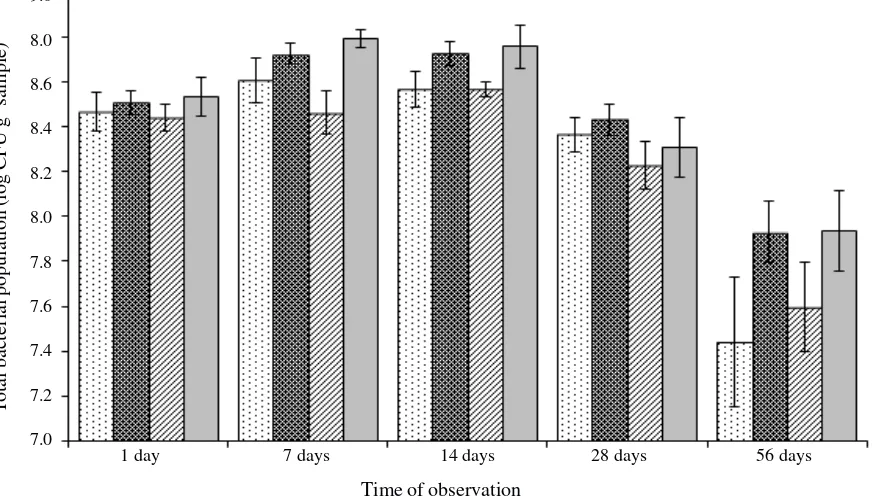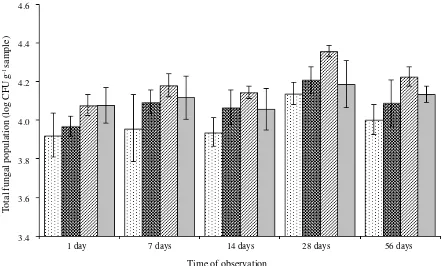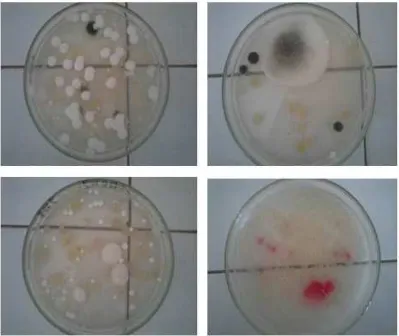J Trop Soils, Vol. 18, No. 1, 2013: 75-80
Inoculation Effect of N
2-Fixer and P-Solubilizer into a Mixture of
Fresh Manure and Phosphate Rock Formulated as Organonitrofos
Fertilizer on Bacterial and Fungal Populations
Sutopo Ghani Nugroho1*, Dermiyati1, Jamalam Lumbanraja1, Sugeng Triyono2, Hanung Ismono3, Missy Kurnia Ningsih1 and Fitri Yani Saputri1
1Soil Science Division, 2Department of Agriculture Engineering, and 3Department of Agribussiness Faculty of Agriculture, University of Lampung, Jl. Sumantri Brojonegoro No. 1, Bandarlampung 35145, Indonesia.
Tel/fax: +62-721-781822, *e-mail: [email protected].
Received 25 May 2012 / accepted 2 January 2013
ABSTRACT
Microbial N2-fixer and P-solubilizer were innoculated in a mixture of fresh manure and phosphate rock formulated as an Organonitrophos fertilizer. The population dynamics of bacteria and fungi growing during the composting process were observed. The inoculation treatments consisted of: K = mixture of 20% phosphate rock and 80% of fresh manure + decomposers (control), N = mixture of 20% phosphate rock and 80% of fresh manure + decomposers + N2-fixer (Azotobacter and Azospirillum sp.) , P = mixture of 20% phosphate rock and 80% of fresh manure + decomposers + P-solubilizer (A. niger and P. fluorescens), and NP = mixture of 20% phosphate rock and 80% of fresh manure + decomposers + N2-fixer + P-solubilizer. The results showed that inoculation of microbial N2-fixer and combination inoculation of N2-fixer and P-solubilizer increased the total bacterial population compared to that of the control as well as the only inoculation of microbial P-solubilizer on the 14th day of observation in which the bacteria reached the highest population. On all the observation days, the population of fungi in the inoculation of microbial P-solubilizer treatment increased significantly compared to that of the control. However, there was no difference between the populations of fungi in the inoculation of N2-fixer and combination inoculation of N2-fixer and P-solubilizer. The genus of fungy identified in the compost of the mixture of fresh manure and phosphate rock were
Chytridium sp., Aspergillus sp., Rhizopus sp., and Fusarium sp.
J Trop Soils, Vol. 18, No. 1, 2013: 75-80 ISSN 0852-257X
INTRODUCTION DOI: 10.5400/jts.2012.18.1.75
Keywords: Bacterial and fungal populations, composting, microbial N2-fixer and P-solubilizer inoculations, organonitrophos fertilizer
The main problems of national fertilizer in Indonesia are the expensive price of chemical/ inorganic fertilizers and their uneven distribution in some areas (districts). The price of chemical fertilizers is continuously increasing because most of the raw materials needed, such as fossil fuels and others, for manufacturing the chemical fertilizers are still imported. The high price of fertilizer will generally not be affordable by the farmers, unless it is subsidized by the government. On the other hand, the National Budget (APBN) for fertilizer subsidy increases significantly every year (Kementerian Koordinator Perekonomian Republik Indonesia 2009).
Farmers are generally very dependent on the chemical/inorganic fertilizers for their intensive
cultivation practices and have a tendency of ignoring the use of organic fertilizer. They do not realize that the impact of the application of chemical/inorganic fertilizers continuously in the long term will result in a serious decrease of soil quality (Parnes 1986). Lately, the farmers realize those phenomena and starting to re-use the organic fertilizers. Actually, since 1990, FAO has promoted the program and it called as go organic (Dalzell et al. 1987). Unfortunately, however, the organic fertilizers available in the market are generally poor in quality. Although the common organic fertilizers can provide some essential nutrients for plants, but the nutrient contents are not adequate, particularly N and P nutrients.
raw materials was inoculated with N2-fixer and P-solubilizer microbes, intending to function in increasing the nutrient content of N and solubilizing P from phosphate rock in the compost produced. The compost product is formulated as an organomineral NP fertilizer with relatively enough content of N as well as high soluble-P. The formulated fertilizer is called as Organonitrophos fertilizer. Both sources of the raw materials of the formulated fertilizer are available abundant in Lampung Province, so it is expected that the price of the new formulated organic fertilizer will be appropriately low to be afforded by the farmers. The inoculation of N2-fixer bacteria into the mixture of raw materials of the formulated fertilizer is expected to increase the total population of bacteria, especially the population of N2-fixer bacteria. By increasing the population of N2-fixing bacteria, it is expected to increase the N fixation significantly, which in turn it will contribute to the increase of the N content in the compost product (organic fertilizer). Similarly, the inoculation of microbial P-solubilizer (bacteria and fungi) into the mixture of raw materials of formulated fertilizer is expected to increase the populations of bacteria and fungi. The growing population of P-solubilizers will act synergistically with the H+ of organic acid produced during the decomposition proscess of fresh manure to solubilize P from the phosphate rock (Traina et al., 1986; Kumari et al. 2008). It will be possible when the organic materials such as fresh manure and the phosphate rock were mixed and composted, as it has already been reported by Asea et al. (1988); Soeleman (2008); Noor (2008); Taiwo and Ogundiya (2008); Nugroho et al. (2012).
This research was aimed to study the inoculation effects of microbial N2-fixers (Azotobacter sp. and Azospirillum sp.) and microbial P-solubilizers (A. niger and P. fluorescens) in a mixture of fresh manure and phosphate rock formulated as an organonitrophos fertilizer on the bacterial and fungal populations during the composting process with the purpose to increase the quality of organic fertilizer.
MATERIALS AND METHODS Research Implementation
The materials used were fresh manure obtained from PT. Juang Jaya Abdi Alam, Sidomulyo, South Lampung and phosphate rock obtained from the community mining in the Selagai Lingga, Central Lampung. Prior to mixing, the phosphate rock was exposed to air-dry and grainded then sieved with a 3 mm diameter sieve. The manure was taken in a fresh condition. Phosphate rock amounted of 100
kg and fresh manure amounted of 400 kg (corresponding to a mixing percentage of 20% : 80%) based on finding by Nugroho et al. (2012) were mixed and then was placed in a wooden constructed box with size (180 × 80 × 50) cm3. In the treatment of inoculation of microbial N2-fixer, the bacterial inoculants of Azotobacter sp. and Azospirilum sp. were added with population density as much as 2.97 x 108 CFU g-1 (application per gram material = 1.3 × 106 CFU) and 2.29 × 108 CFU g-1 (application per gram material = 8 x 105 CFU), respectively. The bacterial inoculants of both bacterial species were developed from the pure isolates which had been mixed into the molasses with concentration of 40%. Similarly, in the microbial P-solubilizer treatment, bacteria Pseudomonas flourescens and fungi Aspergillus niger were added with the population density as much as 2.62 × 108 CFU g-1 (application per gram material = 1 × 106 CFU) and 1.21 × 106 CFU g-1 (applications per gram material = 4.2 × 103 CFU), respectively. The two inoculants were also developed from the pure isolates which had been mixed into the molasses with concentration of 40%. In the control treatment, the mixture of the raw materials was only added by molasses with a concentration of 40%. The mixture was then composted aerobically for two months. The composting technique used was a simple batch system in static pile (Diaz et al. 1993; Haug 1993; Misra 2003). During composting process, the box was sealed with plastic to prevent evaporation.
Research Methods
The study was conducted using a randomized block design with four replications. The inoculation treatments consisted of: K = mixture of 20% phosphate rock and 80% of fresh manure + decomposers (control), N = mixture of 20% phosphate rock and 80% of fresh manure + decomposers + N2-fixer (Azotobacter sp. and Azospirillum sp.), P = mixture of 20% phosphate rock and 80% of fresh manure + decomposers + P-solubilizer (A. niger and P. fluorescens), and NP = mixture of 20% phosphate rock and 80% of fresh manure + decomposers + N2-fixer + P-solubilizer.
Measurement of Bacterial and Fungal Populations
Figure 1. The population dynamics of bacteria in the mixture of fresh manure and phosphate rock which was inoculated with the microbial N2-fixer and P-solubilizer. = control, = inoculated with the N2-fixers, = inoculated with the P-solubilizer, and = inoculated with the N2-fixers and P-solubilizer.
9.0
8.0
8.6
8.4
8.2
8.0
7.8
7.6
7.4
7.2
7.0
Time of observation
1 day 7 days 14 days 28 days 56 days
T
otal bacterial population (log CFU g
-1 sample)
plate (petri dish), Quebec Colony Counter (QCC) was used. The total population of the sample (CFU) was calculated by multiplying the average number of colonies by the dilution factor (Poincelot 1982).
RESULTS AND DISCUSSION
The population dynamics of the bacteria during incubation (composting process) of the mixture of fresh manure and phosphate rock are shown in Figure 1. The total bacterial population increased from day 1 to day 14 and decreased thereafter. The increasing pattern of the bacterial population is considered normal, because most of bacteria are grouped as mesophilic type of microbes which initiate the composting process. During the initial stage of decomposition, readily available substrates (proteins, sugars, and starch) are rapidly oxidized. Metabolism of the simpler compounds by mesophiles causes physical and chemical changes in the decomposition environment in the compost pile that eventually selects for those microbes better able to cope with the new substrates and with the increasing heat (thermophilic stage) generated by the mesophiles (Zibilske 2005). The phenomena of increase (in the mesophilic stage) and decrease (in the thermophilic stage) of the numbers of bacteria shown in Figure 1 was in line with the results reported by Poincelot (1982). His report showed that the
numbers of bacteria (determined by plate counting) could increase by two log units, to reach the figure up to 108 g-1 by the end of the mesophilic stage and then decrease to a level of 106 g-1 during the thermophilic stage of the composting process.
The dominant mesophiles bacteria in the compost pile were usually Pseudomonas spp., Achromobacter spp., Bacillus spp., Flavobacterium spp., Clostridium spp., and Streptomyces spp.; whereas the thermophiles bacteria generally consisted of Bacillus spp.; Streptomyces spp.; Thermoactinomycetes spp., Thermus spp.; Thermomonospora spp.; and Microployspora spp. (Strom 1985).
Time of observation
1 day 7 days 14 days 28 days 56 days
T
otal fungal population (log CFU g
-1 sample)
4.6
4.4
4.2
4.0
3.8
3.6
3.4
Figure 2. The population changes of fungi in the mixture of fresh manure and phosphate rock which was inoculated with the microbial N2-fixer and P-solubilizer. = control, = inoculated with the N2-fixers, = inoculated with the P-solubilizer, and = inoculated with the N2-fixers and P-solubilizer.
In the treatment of inoculation with only P-solubilizer, the bacterial population was not differ from that of the control (without inoculation); it also significantly lower compared to that of the inoculation treatment with only N2-fixer or the combination inoculation with N2-fixer and P-solubilizer. The N2 -fixer inoculation consisted of two bacteria strains, there were Azospirillum sp. and Azotobacter sp., whereas the P-solubilizer inoculation consisted of one strain of bacteria Pseudomonas fluorescens and one strain of fungy Aspergillus niger. It was likely that the P-solubilizer bacteria could not proportionally compete with the N2-fixer bacteria in order to grow and to increase the population; so it is therefore, the P-solubilizer inoculation might not affect the total bacterial population (Figure 1).
The population changes of the fungi during incubation (composting process) of the mixture fresh manure and phosphate rock are shown in Figure 2. The fungal populations increased significantly from day 1 to day 28 and decreased thereafter. As it has already been explained that the mesophilic bacteria and fungy present at the start of the composting process begin to give way to thermophiles when the temperature reaches about 40 oC.
Temperature in the pile compost should rise beyond the mesophilic range within a few days, eliminating most of the mesophiles from the hottest
parts of the pile, which reach about 60 oC. Generally, compost piles effectively restrict the free dissipation of heat generated during the decomposition of organic substrates, resulting in a continuous increase of pile temperature (Zibilske 2005). Thermophilic microbes (the bacteria, the yeast, the actinomycetes and the fungi) become more numerous; but the second succession occurs around 60 oC and the microbial participants increase, such as bacteria (principally Bacillus sp.) and fungi (Chaetomium thermophile, Humicola lanuginosa, Thermoascus aurantiacus, and Aspergillus fumigatus), and finally dominate the new hotter environment (Chang and Hudson 1967).
Figure 3. The fungi genus identified in the compost of the mixture of fresh manure and phosphate rock which were inoculated by microbial N2-fixer and P-solubilizer. A = Chytridium sp. (white fibers, uneven edges), B = Aspergillus sp. (black, convex, filamentous), C = Rhizopus sp. (yellowish brown, uneven edges), and C = Fusarium sp. (pink, irregular edges).
(Azospirillum sp. and Azotobacter sp.) in all the stage of composting processes (mesophilic as well as thermophilic decomposition stages) (Zibilske 2005).
The fungal diversity in the compost of the mixture of fresh manure and phosphate rock was not different between all the inoculation treatments. This was likely due to the fungal population growing in the substrates were dominated by fungal strains originated from the decomposer inoculant which was applied into the all inoculant treatments; therefore, the similar fungal genus were indentified in all the treatments. There were 4 genus of fungy were identified, namely Chytridium sp., Aspergillus sp., Rhizopus sp., and Fusarium sp. (Figure 3).
CONCLUSIONS
The inoculation of microbial N2-fixer and combination inoculation of N2-fixer and P-solubilizer increased the total bacterial population compared
to that of the control as well as the only inoculation of microbial P-solubilizer on the 14th day of observation in which the bacteria reached the highest population. On all the observation days, the population of fungi in the inoculation of microbial P-solubilizer treatment increased significantly compared to that of the control. However, there was no difference between the populations of fungi in the inoculation of N2-fixer and combination inoculation of N2-fixer and P-solubilizer. The genus of fungy identified in the compost of the mixture of fresh manure and phosphate rock were Chytridium sp., Aspergillus sp., Rhizopus sp., and Fusarium sp.
ACKNOWLEDGEMENTS
REFERENCES
Asea PEA, RMN Kucey and JWB Stewart. 1988. Inorganic phosphate solubilization by two Penicillium sp. in solution culture and soil. Soil Biol Biochem 20: 459-464.
Chang Y and HJ Hudson. 1967. The fungi of wheat straw compost. I. Ecological Studies. Trans Br Mycol Soc 50: 649-666.
Dalzell HW, AJ Biddlestone, KR Gray and K Thurairajan. 1987. Soil Management: Compost Production and Use in Tropical and Subtropical Environments. FAO Soil Bull. 56. Food and Agriculture Organization of the United Nations, Rome, Italy. Diaz LF, GM Savage, LL Eggerrth and CG Golueke. 1993.
Composting and Recycling of Municipal Solid Waste. Lewis Publishers, Boca Raton, Fla. Finstein MS and ML Morris. 1975. Microbiology of solid
waste composting. In: D Perlman (ed). Advanced in Applied Microbiology. Vol. 19. Academic Press, New York, pp. 113-151.
Hankin LH and RP Poincelot and SL Anagnostakis. 1976. Microorganism from composting leaves: Ability to produce extracellular degradative enzymes. Microbiol Ecol 2: 296-308.
Haug RT. 1993. The Practical Handbook of Compost Engineering. Lewis Publishers, Boca Raton, Fla. Kementerian Koordinator Perekonomian Republik
Indonesia. 2009. Statistik Pupuk Subsidi Nasional. Deputi Ekonomi, Kemenko Perekonomian RI (in Indonesian).
Kumari A, KK Kapoor, BS Kundu and RK Mehta. 2008. Identification of organic acids produced during rice straw decomposition and their role in rock phosphate solubilization. Plant Soil Environ 54: 72-77.
Misra RV, RN Roy and H Hiraoka. 2003. On-Farm
Composting Methods. Land and Water Discussion Paper. Food and Agriculture Organization of the United Nations, Rome. Italy.
Noor A. 2008. Perbaikan sifat kimia tanah lahan kering dengan fosfat alam, bakteri pelarut fosfat, dan pupuk kandang untuk meningkatkan hasil kedelai. J Trop Soils 13: 49-58 (in Indonesian).
Nugroho SG, Dermiyati., J Lumbanraja, S Triyono, H Ismono, Y Triolanda and E Ayuandari. 2012. Optimum ratio of fresh manure and grain size of phosphate rock mixture in a formulated compost for Organomineral NP Fertilizer. J Trop Soils 17: 121-128.
Parnes R. 1986. Organic and Inorganic Fertilizers. Woods End Agricultural Institute, Mt. Vernon, Maine.
Poincelot RP. 1982. The biochemistry of composting. In: RP Poincelot (eds). Composting of Municipal Residues and Sludges. Proceeding Conference on Composting of Municipal and Industrial Sludges, Rockville, Md. Hazardous Materials Control Research Institute, Silver Springs, Md, pp. 33-39. Soelaeman Y. 2008. Efektivitas pupuk kandang dalam
meningkatkan ketersediaan fosfat, pertumbuhan, dan hasil padi dan jagung pada lahan kering masam. J Trop Soils 13: 41-47 (in Indonesian).
Strom PF. 1985. Effect of temperature on bacterial species diversity in thermophilic solid-waste composting. Appl Environ Microbiol 50: 899-905.
Taiwo LH and M Ogundiya. 2008. Microbial solubilization of Ogun rock phosphate in the laboratory and in soil. Afr J Microbiol Res 2: 308-312.
Traina SJ, G Sposito, D Hesterberg and U Kafkafi. 1986. Effects of pH and organic acids on orthophosphate solubility in an acidic, montmorilonitic soil. Soil Sci Am J 50: 45-52.
Zibilske LM. 2005. Composting of Organic Wastes. In: DM Sylvia, PG Hartel, JJ Fuhrmann and DA Zuberer
(eds). Principles and Applications of Soil


